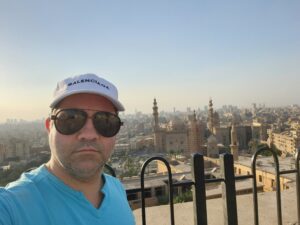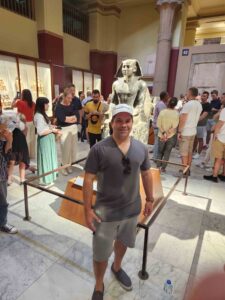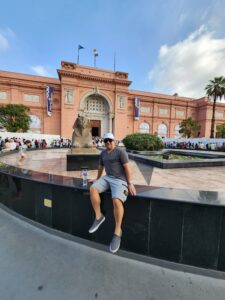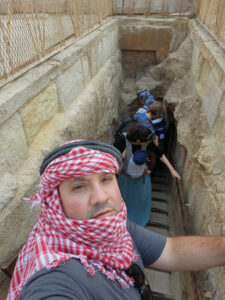Journey to Egypt
Pyramids and Pharaohs through the Eyes of a Wandering Jew
Zvi Goelman
I’ve always wanted to see the Egyptian pyramids. I travel frequently, and when I was in Israel for Sukkos earlier this year, I decided to take advantage of the short 40-minute flight from Tel Aviv to Cairo. Yom Tov ended on a Tuesday night, so on Wednesday evening I packed my bags and made my way to Ben Gurion, excited to add Egypt to the list of countries I’ve visited.
I arrived after sunset and checked into the St. Regis Cairo, which turned out to be a good choice. It’s a beautiful structure with all the amenities you would expect of a high-end hotel. Cairo is a very old, rundown city, and in my opinion somewhat reminiscent of places like Ramallah. I was struck by the contrast between my accommodations and the slum-like conditions of the surrounding area. When I was in my taxi, we passed beautiful, gated communities where there are government offices, closer to the airport. Egypt has great resources of oil and gold, but when there’s corruption, wealth doesn’t end up in the hands of the masses.

I had prearranged a tour through the hotel concierge for my first morning there. My guide picked me up and we visited our first destination: the Egyptian Museum in Cairo. The museum is one of the oldest in existence today. It has thousands of old Egyptian artifacts from the times of the pharaohs and many from the pyramids. My guide explained to me that although every pharaoh was buried with treasures and gold, all the pyramids around Cairo were raided thousands of years ago. In later years, they began to bury the pharaohs in secret tombs further south to protect the valuables. My guide pointed out King Tut’s coffin, which is entirely made of gold, as an example of one hidden tomb that was discovered untouched in the city of Luxor 100 years ago. Luxor is a one-hour flight south of Cairo and is in the area that the Torah refers to as Pisom and Ramses, the cities that the Jewish people built and where all of the stories of Mitzrayim during Moshe’s time took place.





After our visit to the museum, we headed to the Pyramids of Giza, about an hour’s trip by car from my hotel. There are more than 100 pyramids in the Egyptian desert that are thousands of years old. There are only two that are really huge, and one of them is the Great Pyramid, one of the Seven Wonders of the World. My guide told me that the top of the pyramid looks a little different from the rest of it because it used to be covered in gold, but people came along and removed it.
I was fascinated to see the huge stones at the bottom of the pyramid. People don’t understand from an engineering perspective, especially with the tools that they had at the time, how they were able to move such large stones. Even with modern hydraulic machines, it would be considered quite a feat to move them. If you take the Kotel tunnel tours, you’ll see similar stones. It always intrigued me to see them because of that.
I entered the Great Pyramid, also known as the Pyramid of Khufu, through a tunnel which led to a surprisingly narrow passageway that sloped downward towards the burial chamber, which is actually empty.
I walked a few hundred feet to the Great Sphinx, which is huge stone sculpture with the head of a pharaoh and the body of a lion. It was built as a symbol, like a guardian over the tombs, according to my guide.
Bright and early the next morning, my guide and I headed to the old walled city of Cairo called Coptic Cairo, built around the Babylon Fortress. It’s an area full of ancient churches, but the site most interesting to me was the Ben Ezra shul, which was the shul of the Rambam (not to be confused with the Maimonides Shul, also in Cairo). The Ben Ezra shul is the site of the famous Cairo Genizah that was discovered in the late 1800s that led to the publication of many sefarim. There is a legend that states that Moshe was found there as a baby. The shul is assumed to be more than a thousand years old and was rebuilt several times. I would have loved to go inside, but the shul was closed for renovation, so I had to settle for seeing its exterior. Although there are almost no Jews in Egypt, the shul is maintained as a tourist site. I tried to visit another shul called Sha’ar Hashamayim, but I was not able to access it.
The Citadel of Cairo, which dates back to the 12th century, was my next destination. The famous old palace there of Mohammed Ali (not to be confused with the boxer!) who was a leader in Egypt, was converted into a military museum. The museum focused on any successful military engagement against Israel, particularly October 6, the start of the Yom Kippur War. One of the things I saw on display was a part of an Israeli aircraft with a magen Dovid on it. I was looking at it in astonishment and thinking about the peace accords between Menachem Begin and Anwar Sadat, in which Israel gave back the Sinai Peninsula that we had won. It was pretty ironic to see so much celebration of a war in which they were ultimately defeated but I wasn’t about to open my mouth and share that thought with anyone. I kept my mouth shut as well when my guide told me excitedly about an entire neighborhood and a bridge in Cairo named 6th of October.
 There was a flourishing Jewish community in Cairo until around 1947, but today there are only three Jews there. There is no kosher food. There is not even a Chabad. Cairo is a major tourist destination, and Egypt and Israel have diplomatic relations, but it was not a place I felt comfortable as a Jew. I didn’t dare tell anyone I was Jewish. Everywhere I went, locals kept looking at me and asking, “Where are you really from? You’re American, but what is your actual background?” I told them I’m from Brazil originally, because that’s where I was born, but clearly, that was not the answer they were seeking. I did not go to the Jewish cemetery because I did not feel safe, nor did I feel safe walking alone in the streets there at night. The only place I want around a bit was in the old city in the middle of the day when there were a lot of tourists there.
There was a flourishing Jewish community in Cairo until around 1947, but today there are only three Jews there. There is no kosher food. There is not even a Chabad. Cairo is a major tourist destination, and Egypt and Israel have diplomatic relations, but it was not a place I felt comfortable as a Jew. I didn’t dare tell anyone I was Jewish. Everywhere I went, locals kept looking at me and asking, “Where are you really from? You’re American, but what is your actual background?” I told them I’m from Brazil originally, because that’s where I was born, but clearly, that was not the answer they were seeking. I did not go to the Jewish cemetery because I did not feel safe, nor did I feel safe walking alone in the streets there at night. The only place I want around a bit was in the old city in the middle of the day when there were a lot of tourists there.
You need two full days to see Cairo, so I spent Thursday and Friday touring and stayed in my hotel for Shabbos. I had food with me, and it was tolerable, but I didn’t go anywhere. I left back to JFK on Sunday morning. My regret is not having time to visit Luxor, because there’s so much history there. That will have to wait for another trip!
There’s one thing you have to be very careful of, and this is not something that happens only in Cairo. Beware of tourist traps, especially if you’re not using a guide you can trust. On this trip, someone tried to corner me into buying a concentrated oil for $500 that was supposedly used by the pharaohs. My guide wanted to take me to a place where he said they make papyrus. A lot of these places are scams, and the guides get commission. I learned this lesson the hard way once on a trip to China when I was scammed into buying some very expensive tea bags by a shady tour guide.
You must be logged in to post a comment.